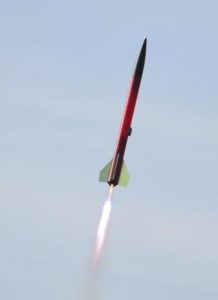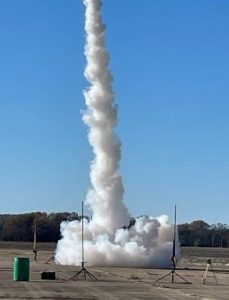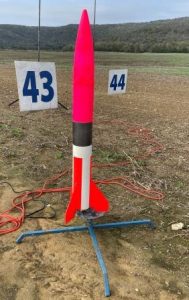Saturday’s (February 8) launch is scrubbed!
HARA at 46
About the time you reach middle age you stop counting the birthdays like you used to, maybe because of the math, and begin to round off saying you are “forty-something”. HARA has been around awhile, has done a lot, and is still doing. It’s worth a moment to remember and appreciate that.
January paused its wintery precip and allowed the club to fly on a cold but clear day. The road on the farm was fine for cars but there were slick muddy spots in the field requiring rocketeers to ‘walk without rhythm’ like on Dune to get through the peril. The new launch policy is if the regularly scheduled launch on the second Saturday is scrubbed, the fourth Saturday becomes the next attempt. This month that worked out with a fair number of attendees and over 60 flights for the day including the annual ‘Geezer TARC’ shootout.
Launch is GO for this Saturday (January 25)!
Rocketeers,
We are a go for launch this Saturday 25 Jan at our Jackson 5 field starting around 9:30… weather looks great just a bit chilly, dress warm. We will have a vendor onsite.
Vendor info.
New Century Rocketry. He has said if anyone pre-purchases anything from him prior to Saturday he will give 10% off your purchase.
List of Motors here
Website: https://newcenturyrocketry.shop
Let us know if you plan on taking your L2 exam and if you need the NAR or Tripoli exam.
See you Saturday!
Doug Aguilar
HARA President
Launch scrub!
Saturday’s (January 11) launch is postponed to January 25 due to projected snow/ice and hazardous travel conditions.
Ready, Set, ARC
This year is the 23rd and biggest year in the history of the American Rocketry Challenge (ARC/TARC). According to the director at the close of registration there were 1,006 enrolled teams, the largest number in the history of the program, well above the previous high of last year’s 922.
This is the list of the currently registered Alabama teams.
Thompson High School, Alabaster
Cullman High School, Cullman
Central, Florence
Rogers High School, Florence
Hackleburg High School, Hackleburg
Haleyville City Schools, Haleyville 2 teams
Alabama School of Cyber Technology and Engineering, Huntsville 4 teams
St. John Paul II, Huntsville 4 teams
Columbia High School, Huntsville
Sparkman High School, Huntsville
James Clemens High School, Madison
Bob Jones High School, Madison
Alabama School of Mathematics and Science, Mobile
Lawrence County High School, Moulton
Muscle Shoals High School, Muscle Shoals 3 teams
Phil Campbell High School, Phil Campbell
Tharptown High School, Russellville 2 teams
Russellville High School, Russellville 3 teams
Tuscumbia City School, Tuscumbia
Winfield City High School, Winfield
Tharptown High School is the reigning ARC National Champion and is back to defend its title. The state team number is down two from last year but still has 32 total teams from 20 schools, 6 with multiple teams. The Huntsville area team number grew by one.
What the NAR is doing with ARC is really making a difference to the future of the US aerospace industry, to the rocketry hobby, and to the future of the NAR. Support these students in every way you can.
Courting Courtland
The Propel Science Foundation (PSF) invited HARA back to the old Courtland airport 12/7 for a day of open sport flying. Having established the old airport as a launch field the director of PSF, Andrew Heath, set up the date as a possibly reoccurring event, which is exciting news for north Alabama rocketeers. HARA brought the range equipment and personnel to support all levels of rockets. The clear calm air allowed high flights with big and small motors. Parking on the runway was great, the large recovery space was great, rockets landing on the concrete -not so much. About 45 models were launched.
Launch scrub!
Due to forecast high winds above the 20 mph limit, this Saturday’s (December 14) launch is cancelled.
HARA at NSL East
A national high power sport launch less than 7 hours drive from Huntsville was enough to attract some HARA members to attend and fly. The NAR had sanctioned an event in the west around Memorial Day and NSL East was held November 23-25 in a SE Georgia cotton field hosted by the Southern Area Rocketry (SoAR) section with 230 registered flyers and many spectators and supporters. The three days had 750 flights total– 368 flights Saturday including a night launch, 275 flights Sunday, and 107 flights Monday. SoAR often hosts a regional fall launch on this field but this year it went national.
The weather was clear every day and perfect for high flights. Stan put up a bird to 8K’ and got it back, Doug flew his Level 2 certification attempt and Vince burned two H’s, two I’s and a J motor. Many cool rockets of all power levels were on parade on the flight line and on the pads. A beautiful giant scale 12′ tall Saturn V had a majestic liftoff unfortunately without all it’s motors lit. It went up only a few hundred feet and laid over defeated by gravity. Most of the other flights were much better as modelers successfully showed off their craftsmanship and flying skills.
See this excellent news coverage at
https://fox5atlanta.com/video/1562547
Under the Weather
Despite the low ceiling HARA got out to the field for the November launch. Flyers were advised to only bring medium motors to stay under the clouds and they did. There were still plenty of sport flights, ARC practice rounds, student team projects and L1 certs to fill the morning. As rain drops began splattering at 12:30 everyone scrambled to pack up and go, but half a day on the range was better than nothing.




































